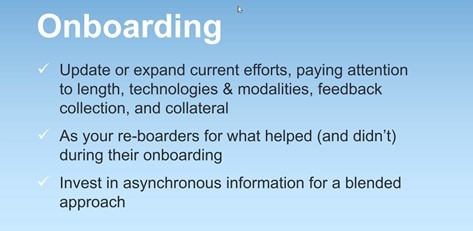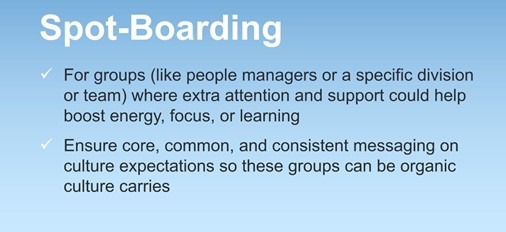3 steps to onboard and retain culture champions
Looking for ways to counter The Great Quit? Here’s how to attract and engage employees who will stay—by creating, communicating and cascading a powerful culture.

More than 4.4 million Americans quit in September, and government data shows record numbers still climbing.
So how do you attract, engage and retain talent who believe in your mission and will stay for the long haul? You create an engaging culture, says Ragan Consulting Group consultant Kristin Graham.
A former culture exec at Amazon, she shared how it’s done in Tuesday’s Communications Week webinar, “Engaging Hearts & Minds Through Strategic Onboarding.”
Here are her top takeaways:
1. Treat culture like a strategy—not a tactic.
“Culture is the welcome mat to your organization for new hires,” Graham says. “Culture must now be a living, breathing organism—not some poster in the company kitchen. It’s the sum of the promises a company makes and keeps.”
Sounds good in theory, but how do you actually create a living, breathing culture for new hires and long-term employees? Graham says it comes down to aligning the “3 E’s of Culture”:
- What employees are told to EXPECT: Examples include offering prospects and new hires flexibility, remote work opportunities and even a more inclusive culture.
- What employees actually EXPERIENCE: “Expectations must match what employees see once they actually accept the job,” says Graham. For example, it’s a disconnect if you’re promoting an inclusive culture, but a new hire doesn’t feel like he/she/they belong. “Those kinds of disconnects can destroy employee culture,” she says.
- What discretionary EFFORTS employees are willing to give: “We trade our time for our paycheck as employees,” Graham says. “But there’s also discretionary effort where we go above and beyond—and that doesn’t translate to ‘hours worked.’ This is how employees ‘return back’ to the culture by amplifying and extending it.”
2. Embrace the role of “embedded journalist.”
“Internal communicators are the embedded journalists of our organizations,” according to Graham. “It’s our responsibility to hear and then amplify what is or isn’t working in the organization.”
Here are some quick ideas for translating that into reality:
- Listen and investigate. “With all respect to HR, many employees are hesitant to write anything down about the company culture, much less how it is or isn’t meeting expectations,” Graham says. “So the onus is on us to hold a safe space for them to have those honest conversations. We also have to be willing to ask the hard questions.”
- Watch for meaningful moments. “In today’s remote reality, it’s more important than ever to watch for signs of disengagement,” says Graham. “Silence on Zoom calls is a sign to investigate. Another is when the cameras go off. Those are prompts to ask yourself, ‘What questions am I not asking?’ and then to adjust accordingly.”
Similarly, watch for signs of employees being overwhelmed or overextended. In a remote or hybrid work environment, signs of a stressed or fractured culture can include:
- Meetings at 8 a.m. or 5 p.m.
- Being scheduled over lunch.
- A false sense of urgency (by management).
- Improperly scoped projects.
- Too many meetings.

- Empower your ERGs. Employee resource groups represent true “discretionary effort,” because involvement isn’t required. They’re also where employees are more likely to be vocal about your culture, according to Graham.
That’s why she recommends ramping up your ERG program—within reason. “If you have a brown-bag session, a focus group, an ERG meeting and then also have to do your work—it can be overwhelming,” she explains. “People need to be able to step away.”
- Preach, practice and promote authenticity. “Empty words kill culture,” Graham says. “Real action and effort must be behind any culture initiative,” Graham says. “It doesn’t have to be overly strategized. Fast and messy can earn trust, because it’s not overthought—it’s happening in the moment and shows progress.”
- Provide feedback and learning opportunities. Graham says one of the hard questions to ask is, “Where are we getting feedback beyond an annual pulse survey or performance review?”
The answer might surprise you. “Employees want you to ask them about their experience repeatedly and over time to get a feeling as to where you’re going together,” she explains. “It needs to be more like having a conversation—not just filling out a comment card.”
3. Translate culture into all phases of onboarding.
Prospects, current staff and even former employees are all talking about your culture, whether you know it or not, says Graham. Just search for your organization on Glassdoor and you’ll see it’s true.
That’s why onboarding—in all its phases—is a such a crucial component of creating, communicating and cascading a winning culture. Here’s Graham’s advice:
- Pre-boarding tips: Pre-boarding includes efforts before an official start date. Employees are never more engaged than when they start, notes Graham.

“But don’t just assign a bunch of videos to watch,” she says. “Instead, send a welcome kit to the house. Or create a digital link for them to see corporate history, leader videos, information on employee affinity groups and, yes, benefits information.”
In other words, “Give them a culture appetizer that says, ‘I’m really glad you’re here,’” she adds. “Digitize brochures about your company and show them the whole car, not just the tires (aka, benefits).”
Pre-boarding should always be optional and should only take a couple of minutes. Don’t make a new hire sit through a two-hour training session, Graham warns.
- Onboarding tips: Traditional onboarding now covers everything from new benefits to social distancing policies and guidelines to your hybrid work approach.

Graham adds that accessibility issues matter now more than ever. “This is the time to make sure you have screen readers, closed captions, translations and more,” she says. “This is the first place to put accessibility and inclusion into your communications and procedures. So if you’re sharing a video, include the clicks to ‘hear translation’ or ‘here’s the transcript.’”
She also advises “making your leaders downloadable.”
For example, Amazon has 15 leadership principles. “[When I worked there], we provided videos of leaders speaking on the principles,” Graham shares. “Each was three minutes or less and included captions, transcripts and translations.”
She suggests allowing new hires to come back and “retouch the hard work you delivered.” In other words, an employees’ first days might be too intense to absorb a lot of new information—so give them access to a library of culture materials, she suggests.
- Spot-boarding tips: This is where managers or employees who have been on board for longer periods get extra attention and support. It also includes areas where you’re hearing that there are conversations about the culture you should speak to.

Don’t just focus on unhappy employees, Graham advises. “Also get input from all-stars and people who love the organization,” she says. “They can help you focus on what to amplify.”
Also keep in mind that spot-boarding doesn’t have to be time-bound.
“It’s about finding places where you need an infusion of energy to convey and build culture,” Graham says.” It’s also about giving employees the resources to help you carry the culture forward—whether it’s an intranet or wiki pages they can access later.”
Graham is quick to point out that all these ideas are “easier said than done.” Her goal, however, is to inspire communicators to inspire employees—new and long-term alike.
“If you find joy in this, so will others,” she says. “Be creative, and allow your best ambassadors to leave ‘cultural fingerprints’ on the organization.”
For Graham, that can include eschewing tech and apps—and embracing traditional “walls and halls” efforts like Post-Its on team bulletin billboards or hallways.
“Don’t underestimate a spot of color,” she says. “When, and if, we come back to the physical office, you’ll want to create opportunities for people to participate in a fun way in your culture—and in a way that amplifies it.”

Brian Pittman is the Dean of Ragan Training and a Ragan Communications event producer. For more information about Ragan Training, contact him at brianp@ragan.com.







